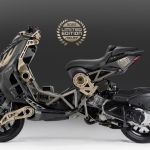
Honda NSX: The Birth of a Myth
Tokyo's "little one" that frightened the West
June 8th, 2020
Towards the end of the 1980s, Honda decided it was time to make its voice heard and show to European manufacturers that the Japanese were capable of designing cars as high-performance as the well-known Ferrari, Porsche and Lamborghini. The goal was ambitious to say the least, so Honda devoted a lot of resources to the NSX project and for its development, it turned to nonetheless than Ayrton Senna, the Brazilian Formula 1 champion driver who at the time was already under contract with the company. Despite Honda was Tokyo-based, the design was commissioned to the Italian Pininfarina, who was the reference point at the time, having designed the most beautiful European sports cars. The directives were clear: the car must be fast but easy, usable even on a daily routine without too much effort.
Ayrton gave valuable advice to Honda technicians, as he used to do with his fellow engineers in Formula 1. After several tests carried out on important circuits such as Suzuka and Nurburgring, the final version was presented in 1989 and put on the market in 1990. Everyone immediately understood the importance of the project and its cultural meaning, as well as the quality of its technical solutions: the chassis was completely in aluminium, and it featured a large presence of light material such as titanium and a 270 hp V6 engine, which mounted on such a light car, was able to give incredible emotions.
The importance of the NSX-Senna combination
Following 3 world titles (1988, 1990, 1991) and having lended his image to commercials and track tests, Ayrton Senna was the undisputed star of Japanese drivers. Honda, considered the success of the first series, presented the new version NSX-R: an even more racing version, where the interior is made even more racetrack with Recaro seats in composite fibre and with a further weight reduction.
The success of this partnership is confirmed by the many promotional videos that Honda sent all over the world. In particular, there is one that shows Senna's enormous talent, associated with his impeccable style, always at ease in any situation. In 1992 at the Suzuka Circuit, Senna is walking in "civilian clothes" and is about to test the new NSX-R in front of journalists' eyes and cameras. After a meticulous inspection of the vehicle in its smallest parts, Ayrton gets behind the wheel, starting off in a wheel spin. The real gem of the video is a camera aimed at the pedals, which shows us Senna's casual outfit, with leather moccasins with white socks on his feet, moving elegantly and in pure racing style on the pedals, performing the mythical "heel-toe" with a naturalness and disarming ease.
Those were the times when Formula 1 drivers were able to drive any vehicle with confidence, given the difficulty of driving "real" single-seaters on the track, very different from today's. But Senna, Senna was something else.






























































